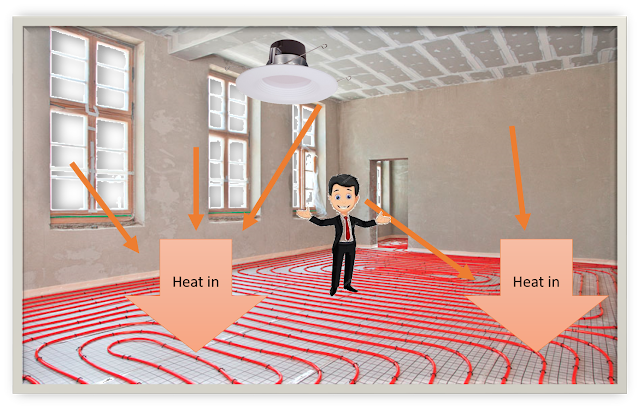Vapour compression air conditioning system served the cooling necessities all these years much effectively. But now due to serious climate change issues associated with this technology as the VCR system ends up adding plenty of heat to the environment along with cooling your conditioned space hunting for alternative cooling technologies started. Practically for 'N' number of reasons, entire vapour compression systems cant be replaced with an alternate cooling solution but to some extent, they can be substituted. Out of many such alternative cooling technologies, Indirect evaporative cooling and Radiant cooling technologies are proven as best.
Conventional Radiant Cooling
A radiant cooling system is a temperature-controlled surface that cools indoor temperatures by removing sensible heat and where more than half of heat transfer occurs through thermal radiation. The heat will flow from objects, occupants, equipment and lights in a space to a cooled surface as long as their temperatures are warmer than that of the cooled surface and they are within the line of sight of the cooled surface. The process of radiant exchange has a negligible effect on air temperature, but through the process of convection, the air temperature will be lowered when air comes in contact with the cooled surface.
Advancement
In the advanced version, radiant cooling pipes are smart. These pipes are connected to multiple zones of a building and all these are centrally controlled smartly. This advancement actually balances the building thermal load by distributing the heat uniformly in all zones of a building. In general, if we see few zones of a typical house like wash areas, shady areas and all are relatively cooler than that of the ones which have high thermal loads. A normal vapour compression system takes away this heat from the conditioned space and put it in the environment. But in this case, the heat energy from a relatively cooler zone is taken and put in the zone which is relatively cooler. This simple advancement can have a significant benefit in reducing the cooling related costs.
A Swedish company has got patented technology for this advanced radiant cooling technology. The system will balance the temperature of each room and reuse excess temperatures wherever needed. They have demonstrated significant savings for both cooling and heating applications of a building. This technology supplier has introduced a Viable City Concept that allows the system to connect an entire city to achieve optimal savings, in energy, CO2 emissions, and water usage. In this setup, the system works through a complex grid system connecting all buildings, zones, and renewable energy sources to allow a whole city to become Near-Zero.
The only hurdle for this technology to get implemented widely is the initial capital cost and major civil work associated.
Case Study:
Volvo showroom has gone for installing this advanced radiant cooling system and achieved nearly 47.5k units of electrical energy. This has resulted in a reduction of around 24 units/m2.







This was a llovely blog post
ReplyDelete